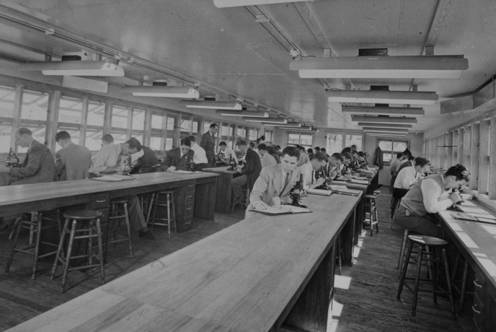Mission, Values, and History
Mission
Promoting health and a healthy society that enables individuals to achieve their full potential
We:
- EDUCATE
Physicians, scientists, and caregivers optimally prepared to serve the needs of patients and society - DISCOVER
Research that solves for unmet needs by finding better treatments, cures, and prevention with a commitment to ensuring real world application - HEAL
Best care possible today, with continuous improvement and innovation for better care tomorrow
Values
- Excellence: We strive for the highest standards of clinical excellence, educational distinction, research integrity, and administrative quality in all we do. We are rigorous in our commitment to ongoing improvement.
- Innovation: We endeavor to develop new knowledge about diseases and treatment, enhance the lives of patients through better care and treatments, creatively approach challenges, and inspire the next generation of physicians, scientists, and health professionals.
- Teamwork: We work collaboratively and with a shared purpose, drawing on our diverse backgrounds, talents and ideas, and bringing an unwavering integrity to everything we do.
- Compassion: We foster an environment in which patients, visitors, and colleagues are treated with respect, dignity, and kindness in every encounter, every day.
History
The story of UT Southwestern Medical Center is one of commitment to excellence, dedication to discovery, and service to the community. It's also a story of phenomenal growth, fueled by exceptional people with an extraordinary vision: to establish an academic medical center second to none.
Since its formation in 1943, Southwestern Medical School has grown from a small wartime medical college into UT Southwestern Medical Center, a multifaceted academic institution nationally recognized for its excellence in educating physicians, biomedical scientists, and health care personnel.

Under the leadership of the late Edward H. Cary, M.D., and Karl Hoblitzelle, a group of prominent Dallas citizens organized Southwestern Medical Foundation in 1939 to promote medical education and research in Dallas and the region. When Baylor University elected to move its school of medicine from Dallas to Houston in 1943, the Foundation formally established Southwestern Medical College as the 68th medical school in the United States.
When a new state medical school was proposed after World War II, leaders of Southwestern Medical Foundation offered the college's equipment, library, and certain restricted funds to The University of Texas, provided the University would locate its new medical branch in Dallas. The Board of Regents accepted this offer from the Foundation, and in 1949 the college became Southwestern Medical School of The University of Texas. In 1954 the name was changed to The University of Texas Southwestern Medical School. The present campus site on Harry Hines Boulevard was occupied in 1955 upon the completion of the Edward H. Cary Building. This placed the Medical School faculty next to the newly built Parkland Memorial Hospital.
In November 1972 the name and scope of the Medical School were changed with its reorganization into The University of Texas Health Science Center at Dallas. In approving the concept of a health science center, the UT System Board of Regents provided for the continued growth of coordinated but separate medical, graduate, and undergraduate components, interacting creatively on the problems of human health and well-being.
In 1986 the Howard Hughes Medical Institute (HHMI) opened a research facility on the campus. Concentrating on molecular biology, it has brought outstanding scientists to head laboratories in their specialties. These investigators also hold faculty positions in the basic science departments of the Medical and Graduate schools.
In October 1987 the UT System Board of Regents approved changing the name of the health science center to The University of Texas Southwestern Medical Center at Dallas, reconfirming its original Southwestern identity. The Medical Center currently encompasses UT Southwestern Medical School, UT Southwestern Graduate School of Biomedical Sciences, and the UT Southwestern School of Health Professions.
In October 2009 the UT System Board of Regents and the Board of Trustees of the Seton Family of Hospitals approved the creation of a new partnership with UT Southwestern for medical education and research. The partnership significantly increased the number of residents (doctors in training) practicing at Seton facilities. The agreement also bolstered medical research projects conducted by the Seton Family of Hospitals, and allowed for the expansion of collaborative research efforts with UT Southwestern and The University of Texas at Austin.
The partnership led the UT System Board of Regents to in February 2011 approve changing the institution’s name to The University of Texas Southwestern Medical Center, stripping “at Dallas” from the name. The change was intended to reflect the growing breadth of the school, which includes clinical facilities in Frisco, Las Colinas, Lewisville, Park Cities, Plano, and Richardson, along with the Harold C. Simmons Comprehensive Cancer Center and the new Monty and Tex Moncrief Medical Center in Fort Worth.
UT Southwestern is located on Harry Hines Boulevard, a 10-minute drive northwest of downtown Dallas. Since the late 1960s the university has grown to include 15.3 million square feet of space with another 1.4 million square feet under construction. Affiliated hospitals adjacent to the campus are Children's Health℠ Children's Medical Center Dallas and Parkland Hospital.
UT Southwestern's faculty and residents annually provide care to more than 117,000 hospitalized patients, nearly 360,000 emergency room cases, and oversee nearly 3 million outpatient visits.
The faculty has included six Nobel Laureates, four of whom are active faculty members, 26 members of the prestigious National Academy of Sciences, and 19 members of the National Academy of Medicine (formerly the Institute of Medicine), a component of the NAS.
And as international medical and scientific needs grow, UT Southwestern will keep working to remain at the pinnacle of medical institutions worldwide.
